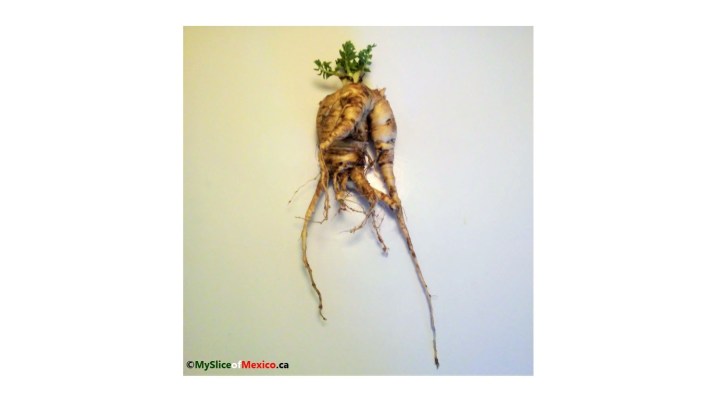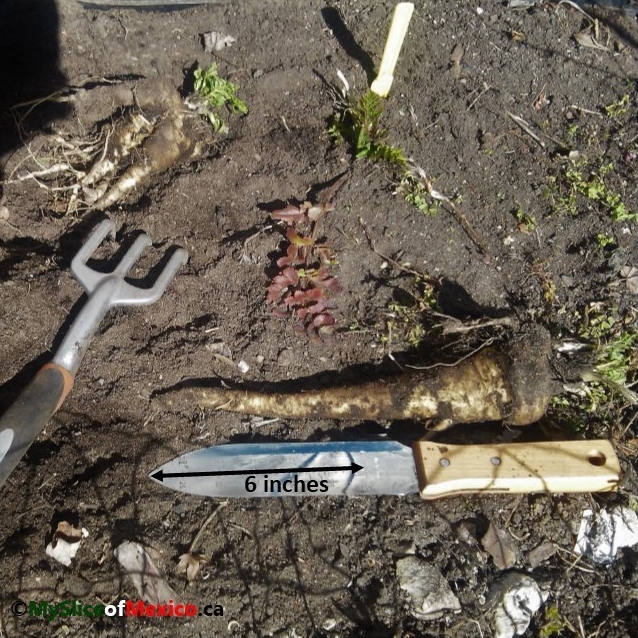
Day temperatures are supposed to be above freezing in my area for the next few days, and the ground is thawing, so this weekend I decided it was time to harvest four parsnips I had left overwintering in the ground. It was sunny, and the soil was nice and lose. I noticed there were only three tiny green tops poking out of the soil; probably the rabbits had a nice late-fall snack. I dug two out, but one had forked and was weird looking. I think it got too much nurturing from the compost I added to the asparagus plot next to it, and -as my favourite Canadian gardening writer Niki Jabbour would have said- it looked like “… Cousin Itt from the Addams Family: very hairy and not appetizing!” [1]. The second one was nice and “Lurch” (LOL). I left the third one in the ground to see if it will bloom, and hopefully will give me fresh seed for my next crop.

Photo: left- forked and hairy parsnip, dug out with hand cultivator; right- parsnip left underground marked with plastic stick; bottom- long parsnip, measured against Hori-Hori garden knife
A lot of gardeners order their seeds for the season early in the year, so they will have them ready when sowing times come. Avid gardeners (euphemism for “impatient gardeners”), such as myself, start making wish lists of seeds to order as soon as the last radish or pumpkin has been picked in the fall. It is fine to dream and plan, but before actually ordering, it is a good idea to check the storage life of the seeds, because some might not be viable even after only one season; if they are being purchased in the fall, there is also a good chance some are leftovers from the previous season, since seed companies are still packing their new batches, collected in the previous months. Parsnip seed is a great example of what not to order too soon; having a one-season viability, and a percentage of germination of about 60%, it is better to buy the seed as close to sowing time as possible. By saving my own seed, I must have the patience to wait for the plant to provide them for me, but I will know they are as fresh as they can be.
 Parsnips are one of those vegetables that I like from my garden, but never had an interest in buying from the supermarket. I mean, to fellow Mexicans, what is even a parsnip? If you know the word in Spanish (from Mexico), please let me know, because I could not find anything that sounded even remotely familiar to me (see Word of the Day – March 18 2018). A friend told me that supermarket parsnips are tough and bitter, but mine are sweet and crunchy; they are so good, the only way I cook them is roasted, sometimes with carrots and a little olive oil, to appreciate their natural flavour and sweetness.
Parsnips are one of those vegetables that I like from my garden, but never had an interest in buying from the supermarket. I mean, to fellow Mexicans, what is even a parsnip? If you know the word in Spanish (from Mexico), please let me know, because I could not find anything that sounded even remotely familiar to me (see Word of the Day – March 18 2018). A friend told me that supermarket parsnips are tough and bitter, but mine are sweet and crunchy; they are so good, the only way I cook them is roasted, sometimes with carrots and a little olive oil, to appreciate their natural flavour and sweetness.
Parsnips have also helped me tame my impatient way of gardening. First, you sow seeds that will take two to three weeks to germinate, knowing that about 40% will never sprout. Secondly, the seed packet says 95 days to harvest, but that is after sprouting, which is basically the rest of the growing season. If that is not enough waiting, parsnips are sweeter after a good frost, when the cold temperatures trigger the plants to store energy in the form of sugar, so add another month to the wait. I tried harvesting one parsnip in the fall once, but it was not very flavourful; instead of (impatiently) ripping the whole crop out of the ground and cooking the tubers with lots of sauce, I paused, took a deep breath, and decided to wait until spring to see if there could be any improvement. And what a reward I got! In the end, it is so true -at least for parsnips- that “good things are worth the wait.”
[1] The Year-Round Vegetable Gardener; Niki Jabbour; Storey Publishing, 2011, North Adams, MA; p. 176.
Related topic: From Seed to Table: Parsnip
Linking to Word of the Day Challenge, September 6 2019 : Zen.








This is so cool, thank you for the post!
LikeLike
I am so glad you enjoyed it!
LikeLike
A very interesting tip, thank you I will give it a try. 🙂
LikeLiked by 1 person